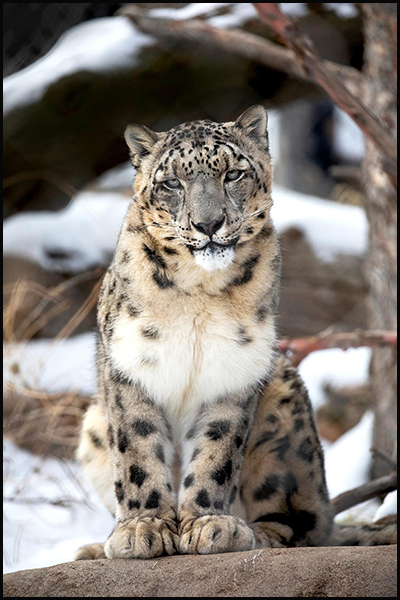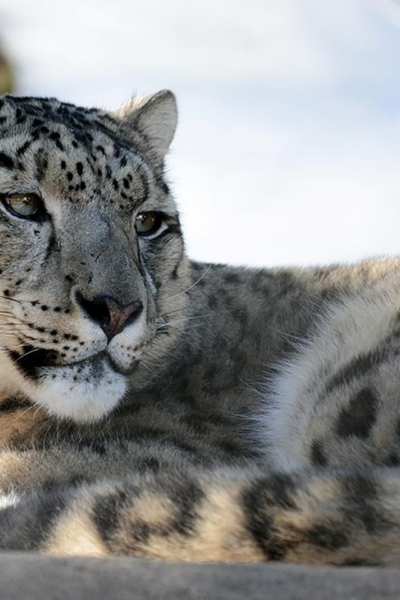FELINE CAPTURED MILLIONS OF HEARTS THROUGHOUT HIS LIFEFTIME – An adored member of the Cheyenne Mountain Zoo animal family died from complications of advanced kidney disease late last week. Following his diagnosis earlier this year, we knew Bhutan’s time with us was limited, but it was still heartbreaking to lose him.

Bhutan, a 15-year-old snow leopard, passed away due to a respiratory event caused by muscle breakdown from the kidney disease. This type of disease is common in all felines, big and small, exotic and domestic. The Association of Zoos and Aquariums’ median life expectancy for snow leopards in human care is 15.1 years.
No matter when we would have had to say goodbye to Bhutan, it would have been too soon. But he was able to live a full lifetime of adoration and care here at CMZoo. In his 14 years with us, he touched millions of hearts with his characteristic tail and feet, and his bouncy personality.
Not all of the animals at the Zoo are as universally loved as Bhutan was. Most Zoo staff are reluctant to name favorites, but truth be told, Bhutan (or “Boots,” as he was affectionately called by his keepers) was at the top of the list for many.
After asking our staff to share their memories of “Boots,” we wanted to share just a sampling of the touching responses we received.
Paulette Provost, groundskeeper, said “Over the years, I have had the honor of seeing Bhutan every morning during my cleaning route. As a groundskeeper, I am responsible for cleaning Scutes Family Gallery, so I was able to visit with him every day. Playing peekaboo with him always filled my soul with joy. I never in a million years thought I would make a friend with a snow leopard! What I know is that not only myself, but everyone else in our Zoo family feels that the world is a bit dimmer without his funny and gentle presence. I will miss him.”

Basia Dann, lead animal keeper in Asian Highlands, said “Bhutan was the best at building a community. I watched him recognize old caretakers, Zoo members who would come visit, docents and volunteers dedicated to educating people about snow leopards and various members of the multi-faceted operations teams at the Zoo. He always had a chuff to give in greeting. He knew and cared for his people fiercely. Whether you were away for your weekend or hadn’t seen him in years, he always seemed to remember and be happy to see you and give thanks for the role you played in his life.”
Amy Tuchman, animal keeper in African Rift Valley and former animal keeper in Asian Highlands, said, “Snow Leopards were ‘it’ for me throughout my entire childhood. I studied them, had tons of pictures, but never actually saw one in real life until I moved to Colorado. Then in 2015, my craziest dreams came true, and I actually got to start working with one! Bhutan. He was sassier than I would have guessed and always had a lot to say but I admired how he was always so true to himself. He kept everyone on their toes and I loved all the games he wanted to play. To gain his trust was a huge accomplishment and he really was the one animal that made me absolutely fall in love with training. He was so smart and fast and up for anything, literally. I asked him to climb a tree one day and he just went for it and it was so much fun that we decided to add it as part of his show. He was exciting and had a huge presence and he will be greatly missed here by so many.”

Courtney Rogers, registrar and former animal keeper in Asian Highlands, said, “Everyone works so hard to be the bridge between the animals we care for and the people who meet them, but Boots didn’t always need our help to make lasting impressions. It was easy to spot the people who knew him…they knew his favorite resting spots in each of his exhibits, knew he’d come say hi if you waited long enough (and he felt like it), could tell when he was excited to hear his keepers walk by. If you think he recognized you and that you had a special relationship with him, well, it’s probably true.”
Snow leopard wild populations are listed as “vulnerable” and “decreasing,” according to the International Union for the Conservation of Nature’s (IUCN) Red List. Bhutan’s genetics are extremely valuable to the Snow Leopard Species Survival Plan, but he always preferred a solo life and was not successful breeding with a female. Bhutan’s sperm is valuable because he doesn’t have offspring and has an extremely high sperm count. His sperm has been collected and is kept in a “frozen zoo.” If the need arises, conservationists can pair Bhutan posthumously with a genetically valuable female snow leopard.

